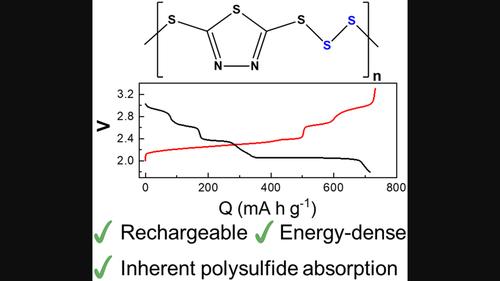当前位置:
X-MOL 学术
›
Energy Environ. Mater.
›
论文详情
Our official English website, www.x-mol.net, welcomes your
feedback! (Note: you will need to create a separate account there.)
2,5-Dimercapto-1,3,4-Thiadiazole (DMCT)-Based Polymers for Rechargeable Metal–Sulfur Batteries
Energy & Environmental Materials ( IF 13.0 ) Pub Date : 2022-06-03 , DOI: 10.1002/eem2.12446 Amruth Bhargav 1 , Arumugam Manthiram 1
Energy & Environmental Materials ( IF 13.0 ) Pub Date : 2022-06-03 , DOI: 10.1002/eem2.12446 Amruth Bhargav 1 , Arumugam Manthiram 1
Affiliation

|
Organosulfur materials are a sustainable alternative to the present-day layered oxide cathodes in lithium-based batteries. One such organosulfur material that was intensely explored from the 1990s to early 2010s is 2,5-dimercapto-1,3,4-thiadiazole (DMCT). However, research interest declined as the electrode reactions with DMCT were assumed to be too sluggish to be practical. Armed with the advances in metal–sulfur batteries, we revisit DMCT-based materials in the form of poly[tetrathio-2,5-(1,3,4-thiadiazole)], referred to as pDMCT-S. With an appropriate choice of electrode design and electrolyte, pDMCT-S cathode paired with a Li-metal anode shows a capacity of 715 mA h g−1 and a Coulombic efficiency of 97.7% at a C/10 rate, thus quelling the concerns of sluggish reactions. Surprisingly, pDMCT-S shows significantly improved long-term cyclability compared to a sulfur cathode. Investigations into the origin of the stability reveals that the discharge product Li-DMCT in its mesomeric form can strongly bind to polysulfides, preventing their dissolution into the electrolyte and shuttling. This unique mechanism solves a critical problem faced by sulfur cathodes. Encouragingly, this mechanism results in a stable performance of pDMCT-S with Na-metal cells as well. This study opens the potential for exploring other organic materials that have inherent polysulfide sequestering capabilities, enabling long-life metal–sulfur batteries.
中文翻译:

用于可充电金属硫电池的 2,5-二巯基-1,3,4-噻二唑 (DMCT) 基聚合物
有机硫材料是目前锂基电池中层状氧化物阴极的可持续替代品。2,5-二巯基-1,3,4-噻二唑 (DMCT) 是 2,5-二巯基-1,3,4-噻二唑 (DMCT),从 20 世纪 90 年代到 2010 年代初,这种有机硫材料得到了广泛的研究。然而,由于人们认为 DMCT 的电极反应太慢而无法实用,因此研究兴趣下降。凭借金属硫电池的进步,我们重新审视了聚[四硫-2,5-(1,3,4-噻二唑)]形式的基于 DMCT 的材料,称为 pDMCT-S。通过适当选择电极设计和电解质,pDMCT-S正极与锂金属负极配对,在C/10倍率下显示出715 mAh g -1的容量和97.7%的库仑效率,从而消除了对电池迟缓的担忧。反应。令人惊讶的是,与硫阴极相比,pDMCT-S 显示出显着改善的长期循环性能。对稳定性起源的研究表明,介观形式的放电产物Li-DMCT可以与多硫化物强烈结合,防止它们溶解到电解质中并进行穿梭。这种独特的机制解决了硫阴极面临的关键问题。令人鼓舞的是,这种机制使得 pDMCT-S 在 Na 金属电池上也具有稳定的性能。这项研究开启了探索其他具有固有多硫化物螯合能力的有机材料的潜力,从而实现长寿命的金属硫电池。
更新日期:2022-06-03
中文翻译:

用于可充电金属硫电池的 2,5-二巯基-1,3,4-噻二唑 (DMCT) 基聚合物
有机硫材料是目前锂基电池中层状氧化物阴极的可持续替代品。2,5-二巯基-1,3,4-噻二唑 (DMCT) 是 2,5-二巯基-1,3,4-噻二唑 (DMCT),从 20 世纪 90 年代到 2010 年代初,这种有机硫材料得到了广泛的研究。然而,由于人们认为 DMCT 的电极反应太慢而无法实用,因此研究兴趣下降。凭借金属硫电池的进步,我们重新审视了聚[四硫-2,5-(1,3,4-噻二唑)]形式的基于 DMCT 的材料,称为 pDMCT-S。通过适当选择电极设计和电解质,pDMCT-S正极与锂金属负极配对,在C/10倍率下显示出715 mAh g -1的容量和97.7%的库仑效率,从而消除了对电池迟缓的担忧。反应。令人惊讶的是,与硫阴极相比,pDMCT-S 显示出显着改善的长期循环性能。对稳定性起源的研究表明,介观形式的放电产物Li-DMCT可以与多硫化物强烈结合,防止它们溶解到电解质中并进行穿梭。这种独特的机制解决了硫阴极面临的关键问题。令人鼓舞的是,这种机制使得 pDMCT-S 在 Na 金属电池上也具有稳定的性能。这项研究开启了探索其他具有固有多硫化物螯合能力的有机材料的潜力,从而实现长寿命的金属硫电池。

































 京公网安备 11010802027423号
京公网安备 11010802027423号